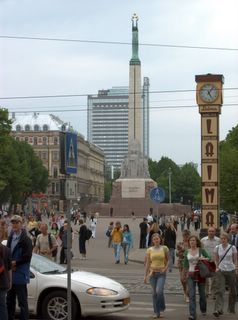Friday, May 27, 2005
Riga, day one
I left Vilnius early this morning for a four-hour bus ride to Riga. My first impression of Riga was that it's much more bustling than Vilnius. There is a swarming indoor/outdoor market right next to the bus station, which I got lost in when I was trying to find the train station (to buy a ticket to Moscow). I also noticed immediately how much more Russian was spoken here than in Vilnius. You hear Russian on the street, in shops, in pop songs over loudspeakers in underground street crossings.
After a while I found the train station, left my backpack and walked to the Old Town. Riga's Old Town is much larger than Vilnius's or Warsaw's. People dress a lot sharper than in Vilnius, like the difference between Florence and Naples. I saw many Benzes, Bimmers and Audis throughout Old Town. The district's architecture and layout is medieval/Baroque.

St. Peter's cathedral, Town Hall square and the House of Blackheads
I had a delicious lunch at a cafeteria called Sietasmates piradzini. Here I tried pirozhki filled with pork, ham and cheese. Three such pastries and a bottle of water cost less than one lat ($2).
I spent the rest of the afternoon in Old Town. Most of the time was in the Occupation Museum. This building chronicles the periods of the 20th century during which Latvia was occupied by Soviet and Nazi forces. The exhibits were informative (although there were far too many photographs and artifacts to focus on with English translations few and far between). From them you could tell that Latvians still harbor a deep resentment toward the Soviets for deporting a great number of their people to Siberia. I wondered if that attitude carried over to the Russians of today. In fact, Russians—not Latvians—are the majority ethnic group in Riga.

Brivibas iela, Old Town's main street
While I was reading a piece about a student uprising against the Soviets in 1940, an elderly man appeared out of nowhere and pointed to a picture of the students. He whispered, "That's me." Then he pulled out his wallet and showed me an ID card. This was, for sure, the same man: Voldemars Treimans. Sadly, all of the participants in the uprising were sent to the gulags and Mr. Treimans was the only survivor. Then, just as quickly as he came, Mr. Treimans disappeared, faster than I could take my camera out to get a picture of him.
That evening I met my CouchSurfing host, a young woman named Vija. Her friend Pavel also joined us. We went to Jurmala, a beach resort 30 minutes from Riga. Jurmala used to be a major tourist destination in the Soviet era, but more recently it has fallen on hard times as more glamorous resorts in the Mediterranean and elsewhere became open to the former Soviet Union. On this evening it was eerily quiet. Jurmala's beach has white sand and goes a long, long way. A few hundred feet inland from the water is a dense forest, specked with once luxurious homes now in disrepair. Yet I saw new housing and retail developments popping up, so better times may be in store for Jurmala.
The weather tonight was nice and it made for a pleasant walk on the beach and in the woods. Vija and Pavel were friendly and we had an interesting conversation. It turned out that we were all working for high-tech companies, so we compared our experiences. They were very interested about life in America. For instance, Pavel asked me about what kinds of cars were popular there, the price of gasoline, and if pirated software was widely used. He also asked me my opinion about President Bush (Bush had paid Latvia a visit recently, the popular Latvian opinion about him was sour).

View from St. Peter's. Old Town, the markets and the television tower are visible.
For my part, I wanted to learn about the dynamic between ethnic Latvians and Russians. Vija (part Latvian, part Russian) and Pavel (full Russian) spoke Russian with each other and everyone else they encountered on this night. It seemed that Russian was the lingua franca of Riga. A decade ago that may have rubbed Latvians the wrong way, but now it was tolerated. Interestingly, there is an official policy of discrimination toward Russians. People who cannot prove Latvian ancestry cannot become citizens; they can't vote and they hold "alien" passports. (Pavel is like this.) There does not seem, however, to be a glass ceiling in the economy for Russians.
Another interesting moment in our conversation came when I asked them if they had ever been to America. They said that they hadn't because the cost of traveling there was prohibitive. And these weren't students; they were were both professionals. What they said made me reflect on my financial situation -- how for the most part, money is not an issue when I want to do something, and until this point I had taken it for granted -- and how other parts of the world view Americans like me.
We returned to Riga and dined at Lido, a popular restaurant that features a buffet of smorgasbord of Latvian cuisine. Latvian food is meat-and-potatoes and somewhat bland. I tried a chicken skewer, radishes, potatoes, a bean or pea dish bathed in lard, and cured pork. This food was extremely rich. My food fit on a regular size plate, but I couldn't finish it. I guess you are supposed to eat everything on your plate in Latvia, because Vija and Pavel looked at me like I had just blown up the National Opera House.


